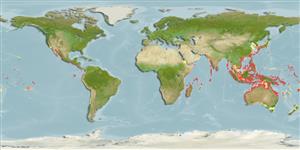Common names from other countries
Environment: milieu / climate zone / depth range / distribution range
Ökologie
seewasser; brackwasser riff-verbunden; tiefenbereich 5 - 40 m (Ref. 90102), usually 12 - 20 m (Ref. 27115). Tropical; 24°C - 27°C (Ref. 27115)
Western Indian Ocean: Maldives (Ref. 30829). Western Pacific.
Size / Gewicht / Alter
Maturity: Lm ? range ? - ? cm
Max length : 12.5 cm TL Männchen/unbestimmt; (Ref. 2334)
Rückenflossenstacheln (insgesamt) : 10; Rückenflossenweichstrahlen (insgesamt) : 12; Afterflossenstacheln: 3; Afterflossenweichstrahlen: 6. Resemble C. oxycephalus but lacks spots on the tail and has a conspicuous opercular ocellus (Ref. 37816).
A common species found in rocky and coral areas of subtidal coastal reefs (Ref. 9710). Enters shallow harbors and estuaries (Ref. 48636). Solitary or in small groups (Ref 90102).
Life cycle and mating behavior
Maturities | Fortpflanzung | Spawnings | Egg(s) | Fecundities | Larven
Pelagic spawner (Ref. 31569). Spawning ascents into the water column occurred over a distance of 0.3 to 0.6 m (Ref. 26305).
Randall, J.E., G.R. Allen and R.C. Steene, 1990. Fishes of the Great Barrier Reef and Coral Sea. University of Hawaii Press, Honolulu, Hawaii. 506 p. (Ref. 2334)
IUCN Rote Liste Status (Ref. 130435)
CITES (Ref. 128078)
Not Evaluated
Bedrohung für Menschen
Harmless
Nutzung durch Menschen
Fischereien: kleinfischerei; Aquarium: Kommerziell
Tools
Zusatzinformationen
Download XML
Internet Quellen
Estimates based on models
Preferred temperature (Ref.
115969): 22.4 - 28.9, mean 27.6 (based on 338 cells).
Phylogenetic diversity index (Ref.
82804): PD
50 = 0.5039 [Uniqueness, from 0.5 = low to 2.0 = high].
Bayesian length-weight: a=0.01585 (0.00637 - 0.03944), b=3.01 (2.79 - 3.23), in cm Total Length, based on LWR estimates for this (Sub)family-body shape (Ref.
93245).
Trophic level (Ref.
69278): 3.5 ±0.55 se; based on food items.
Fishing Vulnerability (Ref.
59153): Low vulnerability (10 of 100).
